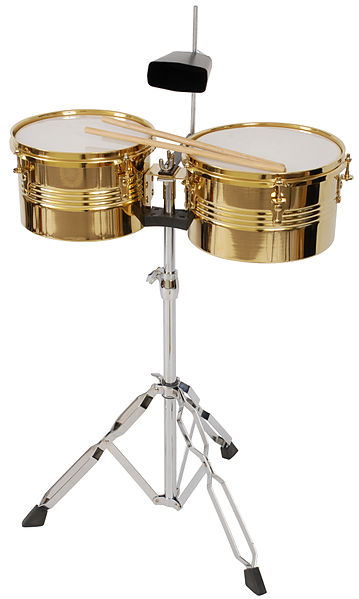Timbales or pailas are shallow single-headed drums with metal casing. They are shallower than single-headed tom-toms and usually tuned much higher, especially for their size. They were developed as an alternative to classical timpani in Cuba in the early 20th century and later spread across Latin America and the United States.
Timbales with a single cowbell
Ubaldo Nieto (center right) on timbales with Machito's Afro-Cubans, 1947
Tito Puente's timbales on exhibit in the Musical Instrument Museum of Phoenix
Arturo Sandoval on timbales at the Hard Rock Cafe, Times Square
Timpani or kettledrums are musical instruments in the percussion family. A type of drum categorised as a hemispherical drum, they consist of a membrane called a head stretched over a large bowl traditionally made of copper. Thus timpani are an example of kettle drums, also known as vessel drums and semispherical drums, whose body is similar to a section of a sphere whose cut conforms the head. Most modern timpani are pedal timpani and can be tuned quickly and accurately to specific pitches by skilled players through the use of a movable foot-pedal. They are played by striking the head with a specialized drum stick called a timpani stick or timpani mallet. Timpani evolved from military drums to become a staple of the classical orchestra by the last third of the 18th century. Today, they are used in many types of ensembles, including concert bands, marching bands, orchestras, and even in some rock bands.
A timpanist
Image: Timpani Range Individual
Walter Light pedal and chain timpani set up in three different combinations.
The inside, bottom of a Yamaha pedal timpano, showing the mechanical tension-adjusting system








